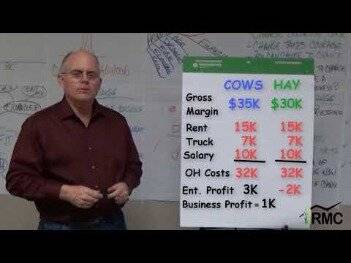What Is Depreciation? Definition, Types, How to Calculate

Larry does not use the item of listed property at a regular business establishment, so it is listed property. Larry’s business use of the property (all of which is qualified business use) is 80% in 2020, 60% in 2021, and 40% in 2022. Larry must add an inclusion amount to gross income for 2022, the first tax year Larry’s qualified business-use percentage is 50% or less. The item of listed property has a 5-year recovery period under both GDS and ADS.
An improvement made to listed property that must be capitalized is treated as a new item of depreciable property. The recovery period and method of depreciation that apply to the listed property as a whole also apply to the improvement. For example, if you must depreciate the listed property using the straight line method, you must also depreciate the improvement using the straight line method.

Larry’s inclusion amount is $224, which is the sum of −$238 (Amount A) and $462 (Amount B). Treat the leasing of any aircraft by a 5% owner or related person, or the compensatory use of any aircraft, as a qualified business use if at least 25% of the total use of the aircraft during the year is for a qualified business use. If someone else uses your automobile, do not treat that use as business use unless one of the following conditions applies. Other property used for transportation includes trucks, buses, boats, airplanes, motorcycles, and any other vehicles used to transport persons or goods. If you dispose of GAA property in a qualifying disposition, you can choose to remove the property from the GAA.
depreciation accounting
Remember that depreciation rules are governed by the IRS, and the method you choose to depreciate your assets will directly affect year-end taxes, so choose wisely. The method currently used by the IRS is the Modified Accelerated Cost Recovery System (MACRS). For example, a company often must often treat depreciation and amortization as non-cash transactions when preparing their statement of cash flow.
However, if the property is specifically listed in Table B-2 under the type of activity in which it is used, you use the recovery period listed under the activity in that table. Use the tables in the order shown below to determine the recovery period of your depreciable property. You are a sole proprietor and calendar year taxpayer who works as a sales representative in a large metropolitan area for a company that manufactures household products.
- You must generally use GDS unless you are specifically required by law to use ADS or you elect to use ADS.
- If costs from more than 1 year are carried forward to a subsequent year in which only part of the total carryover can be deducted, you must deduct the costs being carried forward from the earliest year first.
- This is one reason why many analysts use earnings before tax, interest, depreciation, and amortization (EBTIDA) figures for their financial analysis.
- In May 2016, you bought and placed in service a car costing $31,500.
The accounting profession has addressed this situation with a mechanism to reduce the asset’s book value and to report the adjustment as an impairment loss. When a depreciable asset is sold (as opposed to traded-in or exchanged for another asset), a gain or loss on the sale is likely. However, before computing the gain or loss, it is necessary to record the asset’s depreciation right up to the moment of the sale. Instead, amortization is used to reduce the carrying amount of these assets. Amortization is almost always calculated using the straight-line method. This is the time period over which the company expects that the asset will be productive.
Accumulated Depreciation
There are several allowable methods of depreciation, which will lead to different rates of depreciation, as well as different depreciation expenses for each period. Thus, the depreciated cost balance will also differ under different depreciation methods. The declining balance method is a type of accelerated depreciation used to write off depreciation costs earlier in an asset’s life and to minimize tax exposure.
If you change your cooperative apartment to business use, figure your allowable depreciation as explained earlier. The basis of all the depreciable real property owned by the cooperative housing corporation is the smaller of the following amounts. You can depreciate leased property only if you retain the incidents of ownership in the property (explained below). This means you bear the burden of exhaustion of the capital investment in the property. Therefore, if you lease property from someone to use in your trade or business or for the production of income, generally you cannot depreciate its cost because you do not retain the incidents of ownership.
What Are the Different Ways to Calculate Depreciation?
This was the only item of property you placed in service last year. The property cost $39,000 and you elected a $24,000 section 179 deduction. You also made an election under section 168(k)(7) not to deduct the special depreciation allowance for 7-year property placed in service last year. Because you did not place any property in service in the last 3 months of your tax year, you used the half-year convention.
- Larry uses the inclusion amount worksheet to figure the amount that must be included in income for 2021.
- For example, if an old delivery truck is sold and its cost was $80,000 and its accumulated depreciation at the date of the sale is $72,000, the truck’s book value at the date of the sale is $8,000.
- You are an inspector for Uplift, a construction company with many sites in the local area.
- The recovery period begins on the placed in service date determined by applying the convention.
- For the inclusion amount rules for a leased passenger automobile, see Leasing a Car in chapter 4 of Pub.
For information about how to determine the cost or other basis of property, see What Is the Basis of Your Depreciable Property? For certain specified plants bearing fruits and nuts planted or grafted after December 31, 2022, and before January 1, 2024, you can elect to claim an 80% special depreciation allowance. Generally, the rules that apply to a partnership and its partners also apply to an S corporation and its shareholders.
Sum of the years’ digits depreciation
Depreciation cannot ultimately change the profitability of a company. As the company would already account for the initial investment as a cash outflow. The company will continue to record the depreciation expense in the income statement for the next 10 years. However, as it has already made the purchase, it doesn’t have to make these yearly cash outflows again. The accounting depreciation method follows the matching principle of accounting. The reporting company has the choice of following the accounting rules/standards as well as choosing the depreciation method.
Depreciated cost is the remaining cost of an asset after reducing the asset’s original cost by the accumulated depreciation. Understanding the concept of a depreciation schedule and the depreciated cost is important for both accounting and valuation purposes. Ultimately, 490 west end ave in upper west side gives you a much better understanding of the true cost of doing business. To gain a more accurate picture of your company’s profitability, you’ll need to know depreciation, because as assets wear down and become less valuable, they’ll need to be replaced.
Plante Moran ranked No. 8 as a 2023 top accounting firm by Construction Executive
An employer who allows an employee to use the employer’s property for personal purposes and charges the employee for the use is not regularly engaged in the business of leasing the property used by the employee. To figure depreciation on passenger automobiles in a GAA, apply the deduction limits discussed in chapter 5 under Do the Passenger Automobile Limits Apply. Multiply the amount determined using these limits by the number of automobiles originally included in the account, reduced by the total number of automobiles removed from the GAA, as discussed under Terminating GAA Treatment, later.
What is Accounting Depreciation?
The cost of land generally includes the cost of clearing, grading, planting, and landscaping. If you use part of your home as an office, you may be able to deduct depreciation on that part based on its business use. If you lease property to someone, you can generally depreciate its cost even if the lessee (the person leasing from you) has agreed to preserve, replace, renew, and maintain the property. You can depreciate most types of tangible property (except land), such as buildings, machinery, vehicles, furniture, and equipment.
With the straight line depreciation method, the value of an asset is reduced uniformly over each period until it reaches its salvage value. Straight line depreciation is the most commonly used and straightforward depreciation method for allocating the cost of a capital asset. It is calculated by simply dividing the cost of an asset, less its salvage value, by the useful life of the asset. When a long-term asset is purchased, it should be capitalized instead of being expensed in the accounting period it is purchased in. Assuming the asset will be economically useful and generate returns beyond that initial accounting period, expensing it immediately would overstate the expense in that period and understate it in all future periods. To avoid doing so, depreciation is used to better match the expense of a long-term asset to periods it offers benefits or to the revenue it generates.
Both the asset account Truck and the contra asset account Accumulated Depreciation – Truck are reported on the balance sheet under the asset heading property, plant and equipment. Unlike the account Depreciation Expense, the Accumulated Depreciation account is not closed at the end of each year. Instead, the balance in Accumulated Depreciation is carried forward to the next accounting period. After the truck has been used for two years, the account Accumulated Depreciation – Truck will have a credit balance of $20,000. After three years, Accumulated Depreciation – Truck will have a credit balance of $30,000. Each year the credit balance in this account will increase by $10,000 until the credit balance reaches $70,000.
If any of the information on the elements of an expenditure or use is confidential, you do not need to include it in the account book or similar record if you record it at or near the time of the expenditure or use. You must keep it elsewhere and make it available as support to the IRS director for your area on request. Generally, an adequate record of business purpose must be in the form of a written statement.
This election does not affect the amount of gain or loss recognized on the exchange or involuntary conversion. You figure the depreciation rate under the SL method by dividing 1 by 5, the number of years in the recovery period. The result is 20%.You multiply the adjusted basis of the property ($1,000) by the 20% SL rate. You apply the half-year convention by dividing the result ($200) by 2.



